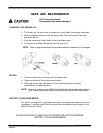
CARE AND MAINTENANCE
PROCEDURE FOR ELECTRIC CLUTCH ADJUSTMENT
Electric clutches require periodic Air Gap adjustments for extended life. Listed below is both an Air
Gap adjustment procedure and an Ohms test to check for a faulty coil within the clutch. No
replacement parts are available to repair a faulty assembly. The entire clutch must be replaced.
A. AIR GAP ADJUSTMENT
1. Remove the clutch from the engine. This is recommended because it is easier to verify the
gap.
2. Locate the three rivet joints which fasten the leaf springs to
the armature, (figure 1)
3. Rotate the pulley until these rivet joints are located midway
along the edge of the triangular field adapter, (figure 1)
4. Locate the three holes in the brake plate, one near each
adjustment nut. (figure 2)
5. Insert a .012 inch feeler gauge into one of the three
windows. Be careful to position the feeler gauge
between the rotor and armature faces, (figure 3)
6. Tighten the adjusting nut adjacent to the window with the feeler gauge inserted until the
gauge fits snugly between the rotor and armature. The gap
should not be so tight that
the feeler gauge cannot be reinserted after removal.
7. Repeat Steps 5 and 6 at the other two windows.
8. Re-check the air gap at each window and make minor
adjustments as necessary to achieve a consistent
.012 inch air gap.
9. Reinstall the clutch to the engine. Be sure to torque the
mounting bolt back to 50 ft. Ibs.
B. OHMS TEST
1. Disconnect clutch from mower wiring harness.
2. Attach the two leads on multi-meter to the two wires
coming from the electric clutch.
3. The reading you receive should be between 2.4 to 2.9 OHMS.
4. If the resistance is outside this range the clutch coil is faulty.
5. If the clutch coil is faulty, the clutch must be replaced.
Page 35


















